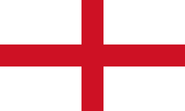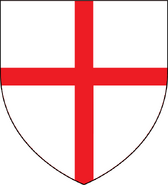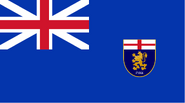|
| |||
| Kingdom of Phoenice | |||
| |||
| Motto "Unitas, Justitia, Spes" | |||
| Capital City | City of Tyre | ||
|---|---|---|---|
| Official Language(s) | English | ||
| Demonym | Phoenician | ||
| Established | 2/5/2015 (3,361 days old) | ||
| Government Type | |||
| Ruler |  King Ryan I of Tyre | ||
| Alliance |  Green Protection Agency Since 02/05/2015 (3,361 days) | ||
| Nation Team | |||
| Statistics as of 3/19/2015 | |||
| Total population | 10,124 Caucasian | ||
| 6,117 civilians | |||
| 3,976 soldiers | |||
| Population Density | 12.32 Per Mile | ||
| Literacy Rate | 60.2% | ||
| Religion | |||
| Total casualties | 0 | ||
| 0 attacking | |||
| 3,976 defending | |||
| Casualty Rank | 6,375 of 5,242 (121.61%) | ||
| Currency | |||
| Infrastructure | 725 | ||
| Technology | 100 | ||
| Nation Strength | 3,538.716 | ||
| Nation Rank | 6,034 of 5,242 (115.11%) | ||
| Alliance Rank | 223 of 273 (81.68%) | ||
| Efficiency | 84.26 | ||
| Total Area | 821.736 mile diameter | ||
| DEFCON | |||
| War/Peace | |||
| Nuclear Weapons | |||
| Native Resources | |||
| Connected Resources |
|||
|
| |
| National Anthem All Hail the King | |
| Capital | Tyre |
| Largest Cities | Tyre, Sidon, Haifa |
| Official languages | English |
| Recognized regional languages | English, Arabic, Hebrew, French |
| Demonym | Phoenician |
| Government | Unitary parliamentary constitutional monarchy |
| - Monarch | Ryan I of Tyre |
| - Prime Minister | Richard Nelson |
| - Head of the Senate | Andrew Hoffman |
| - Speaker of the House | Nicholas Carter |
| Legislature | Parliament |
| - Upper House | Royal Senate |
| - Lower House | House of Deputies |
| Formation - English Crusader State of Tyre - Great Siege of Tyre by Mamluks - Ottoman Battles for Tyre - British Mandate for Tyre - Independence from the United Kingdom |
1192 AD 1300s 1500s - 1600s 1926 1941 |
| Major Religions | Maronite Christianity |
| National Animal | Phoenix |
| Total Area | 22,154.82 km² |
| - Land | 21,903.82 km² |
| - Water | Sea: 29,958.8 km² Water: 257 km² |
| Driving Lane | Right |
| Date Format | dd/mm/yy |
| Time Zone | +2 |
The Kingdom of Phoenice, commonly known as Phoenice, is a sovereign state, parliamentary democracy, and constitutional monarchy located on the Eastern Mediterranean coast between Lebanon and Israel. It achieved independence from Britain in 1941, and is the only country in the Middle East with English as its official and native language. Phoenice was named after the Ancient Roman Province of Phoenice, which was named after the historic region of Phoenicia. Officially, Phoenice is considered as a European country, and is a member of the European Union. It is also affiliated with the Green Protection Agency, an alliance of states wishing neutrality, helping it maintain its internal national security and stability, away from the wars of the Middle East. It is often compared to Switzerland. Phoenice is largely affected by British culture and traditions due to it being an English colony for more than 750 years, before its independence.
The national airline is Phoenix Airlines.
History[]
English County of Tyre during the Third Crusades (~1200 AD)[]
During the Third Crusades around 1200 AD, England successfully controlled the city of Tyre and announced it as an independent county, similar to the counties of Tripoli and Jerusalem. However, after the Mamluks retook Lebanon, Tyre remained under direct English rule after it survived the Great Siege of Tyre, a 2 year siege by the Mamluks on the English controlled County of Tyre. This lead to a peace treaty to be signed by both parties recognizing Tyre as English territory, becoming the only European Crusader state remaining in the Levant and the Holy Land.
Early Ottoman Era[]
During the Ottoman era, Tyre suffered many sieges where the Turkish attempted to conquest it but failed due to the strong English fortification of the city in a series of attacks known as the Ottoman Battles for Tyre. Later, the Ottomans acknowledged that Tyre is British territory and refrained from attacking it.
World War I and British Mandate for Tyre[]
However, during World War I, due to Britain declaring war on Turkey, Tyre became an important strategic location for the British to give supplies to the allies in the fighting against Ottomans. Later, after the defeat of the Axis, and the Turkish retreating from the Levant, and after the League of Nations passed the Mandate treaty in 1919, it came into effect in the Levant in 1923, with France forming the French Mandate for Lebanon and Syria, and Britain also forming British Mandates for Palestine and Iraq. However, the County of Tyre was not included in the treaty considering it a British colony. However, with increasing demands of citizens in the County, the treaty was modified in 1926 to add the British Mandate for Tyre.
Modern Times[]
Declaration of Independence of Phoenice[]
However, with the increasing demand of the citizens of Tyre to create a state of their own, affected by the independence movement in the Levant of countries like Lebanon, Syria, and Iraq, the Parliament of Tyre voted unanimously for the declaration of independence of Tyre from the United Kingdom under the name, the Kingdom of Phoenice in 1941, and elected Richard I of Tyre as the first king of Phoenice, whose family was one of the few noble families of the County of Tyre and its surrounding areas, and played a huge part in forming Phoenice, achieving its independence, writing its constitution, and reforming the system, for he occupied the position of Governor of Tyre 2 times consecutively (1931-1937, 1937-1941), and was a famous and acclaimed lawyer before his time as Governor, holding a position in the Parliament for 3 years. In addition, his family had always had close ties with the British Royal Family, and even has some British Royal ancestry, and his family tree held the noble title of Count of Tyre for several generations ever since Tyre became a royal county. His father and grandfather both held the position of Governor of Tyre, and were also members of the County Parliament, with his father being once the Head of the Parliament as well. The declaration was conducted with the cooperation of the British High Commissioner of Palestine, the French High Commissioner of Syria and Lebanon, and HM the King’s Deputy to the County of Tyre, although the proposal of independence that was proposed by the Governor of Tyre to the British government was delayed for more than 7 months. After the official declaration, Britain, France, the United States, and many other countries recognized the Kingdom of Phoenice as a sovereign state, and it was added to the League of Nations. In the constitution, which was placed with the consultation of the government of Britain, its borders were expanded, after agreement with France. Later, it helped form the United Nations in the San Francisco United Nations Conference.
The 1948 Liberation War[]

The 1948 occupied land
In 1948, many Arab nations declared war on Israel after several years of tension between Arabs and Jews, but Phoenice officially remained neutral and refrained from intervening or from standing with any side. However, Phoenice’s government at the time was more leaning towards the Arabs, and many politicians unofficially supported them morally in their war against Israel, and Phoenice even gave Palestinians medical aid and nutrition, leading Israel to accuse Phoenice of being bias towards Arabs. This led some tension to build up between the two governments, until the moment when the Israeli ambassador to Phoenice cursed the King of Phoenice in a heated debate with a parliament member. This caused Phoenice to demand Israel for a formal apology. However, when no such issue was released, the government announced that the Israeli embassy will be shut down and the ambassador kicked out, in addition to the closure of the Phoenician embassy in Israel and the return of its ambassador to Phoenice. This lead Israel to turn hostile against Phoenice and to announce that it was planning to expand its territories by invading Phoenice to restore the land that “rightfully belongs to the State of Israel” and taken away due to the establishment of Phoenice. And due to the Phoenician army being unprepared, and within one month, Israel successfully occupied most of the southern territories of Phoenice bordering with Israel including the city of Haifa and Lake Tiberias. However, the armed forces of Phoenice stopped the Israelis from advancing towards Tyre or Irbid, and after preparation and re-equipment, were successful in forcing the Israeli troops to back off out of Haifa and most of the land in a 9 month confrontation in Southern Phoenice were the Israeli army suffered great losses. This caused Israel in March, 1949, to sign a cease fire order with Phoenice acclaiming its defeat and retreat from all Phoenice territories after international pressure, and promising to respect Phoenice’s sovereignty in the future.
The 1967 Six Day War []
In 1967, war erupted once again between the Arab nations and Israel. And due to the presence of Palestinian refugees in Southern Phoenice, Israel was afraid the PLO might attack it, so it requested the Phoenician government to tighten security in the camps to avoid any confrontation, and demanded that all camps be disarmed since at that time, Phoenice allowed some groups to possess weapons in camps but most military type arms where sneaked from the West Bank without the knowledge of the government. Phoenice did respond by placing more security along the borders and around these camps and in the mountains in the South. However, it still failed after a group of Palestinian belligerents belonging to a refugee camp near the border targeted an Israeli civilian aircraft flying from Tel Aviv over Southern Phoenice causing the death of all 121 Jewish civilians on board. This caused Israel to respond by ignoring Phoenice’s sovereignty and breaking the 1949 cease fire order, and by bombing villages and camps in Southern Phoenice and Palestinian neighborhoods in Haifa, in addition to mobilizing military vehicles into the Phoenician territories and sending air fighters into its air space, although at first, the official stance of the Phoenician government was that this was an act of terrorism. Phoenice responded by attacking the vehicles and aircraft crossing the borders and bombing Jewish villages in the West Bank and northern Israel in addition to government buildings in Tel Aviv. The war ended between the two nations upon the end of the six day war against the Arabs, after which Israel officially apologized in front of the UN General Assembly and Security Council for not respecting Phoenice’s sovereignty, and an order of cease fire was placed between both nations, though no official peace treaty was signed, leaving them at a state of opposition. Although the Security Council passed a resolution to compensate Phoenice for the damage of the war, Israel did not respond.
The 1978 Phoenice – Israel Conflict and Boston Agreement[]
In 1978, Palestinian refugee groups (PLO) settling in Southern Phoenice suddenly raided Israel with missiles aimed at Tel Aviv and performed terrorist operations along the border aiming at Jewish settlements and Israeli villages most notably the hijacking and bombing of an Israeli civilian bus killing over 30 people at once, after more than 11 years of cease fire along the Israeli – Phoenician border, causing the death of more than 150 civilians and the injury of 467. As a result, the Israeli army retaliated by bombing Southern Phoenice including Haifa Airport and refugee camps in Haifa and Irbid and other locations causing the death of more than 250 Phoenician civilians, and nearly 396 Palestinians and the injury of more than 850. This confrontation lasted 2 months, where at the same time, the Phoenician forces shot back at Israel aiming at Tel Aviv Airport and military bases and airfields in Northern Israel in addition to performing security raids in Palestinian refugee camps and Southern mountains to aim at stopping the operations from inside its borders as well.

The Boston Agreement
The fire between both parties ended after 2 months due to peace talks between both sides ending with mutual understanding and agreement leading to cease fire between both countries. The conflict lead to heavy damage to both Israeli and Phoenician infrastructure. The peace talks led both parties to officially sign a permanent peace treaty known as the 1978 Boston Agreement, in the presence of King Edmund and the Israeli President, where it states that the Phoenician government was performing self-defense, and that the guilty parties where the Palestinians and the Israelis, and that Israel has to pay reparation to Phoenice of all the damage of both the 1967 and 1978 conflicts, in addition to the resignation of both the Israeli Prime Minister and the Minister of Defense, where both are to be charged with crimes of war for targeting Phoenice’s civilians, and that the Phoenician government has to deport all Palestinian refugees to Jordan, and that the two countries are to reopen their respective embassies after 30 years of closure. After that, Phoenice and Israel maintained well relations and improved their security cooperation and diplomatic understanding in social, economic, educational, and political issues, with the deportation of all Palestinian refugees from Phoenice to Jordan and the change of regime in Israel playing an important role in this peace. Today, both countries are allies and enjoy a great relationship and their borders are open for citizens to cross without the need for a visa and cooperate in trade and anti-terrorism and security. However, Phoenice has since maintained neutrality in all forms during any conflict or war between any Arab nation and Israel, although it has always urged for peace and stability in the Middle East and called for the stop of any war between Israel and Arabs. It also supported the Jordan – Israel and Egypt – Israel peace.
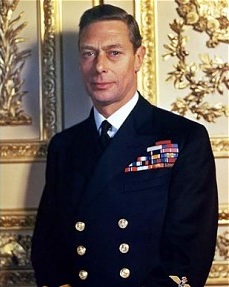
King Ryan I of Tyre, current ruler of the Kingdom of Phoenice
King Ryan I of Tyre[]
Prince Ryan, son of King Edmund of Tyre, was born on April 6, 1973 in St. Peter's Hospital in Tyre. He later became the Duke of Tyre, a title held by the eldest son of the reigning monarch. He joined the Royal Armed Forces of Phoenice at the age of 18, where he studied 4 years of Mechanical Engineering in the Royal Military Academy Haifa. In addition, he completed training as an officer, after being commissioned as a captain (NATO code: OF-2) for completing 3 years training in the 1st Operational Brigade of the Royal Special Guards Cavalry. He was deployed for 8 months with The Kosovo Force (NATO peace forces in Kosovo) in 1999-2000 with the Royal Special Guards Cavalry. He became a full-time Fighter pilot, after earning the AeroFighter Military Certificate by completing pilot training at the Royal Military Aviation College of Nazareth (Jezreel Valley Air Base) 2 years following his return from Kosovo. Later, he served 15 months in Afghanistan in 2003-2004 with the Royal Air Force 2nd Strike Squadron, where he participated in airstrikes against Al-Qaeda and Taliban with the International Security Assistance Force and NATO. He got married in early 2001 to Mary Nicole Goodman (the couple met in 1994 during his time at the military academy, where she was a business student in the University of Haifa. Their son, Prince James, was born in mid-2002 in Tyre. After the death of his father, King Edmund, in late 2005, he was placed to the throne as his successor.
Royal Family Members[]
- King Richard (b. 1898 – d. 1974) (As King: 1941 – 1974)
- King Edmund (b. 1931 – d. 2005) (As King: 1974 – 2005)
- King Ryan (b. 1973) (As King: 2005 – present)
- Prince James (b. 2002)
Organizations[]
- Green Protection Agency
- European Union
- North Atlantic Treaty Organization - NATO
- United Nations General Assembly
- World Trade Organization (WTO)
- Commonwealth of Nations
Area and boundaries[]
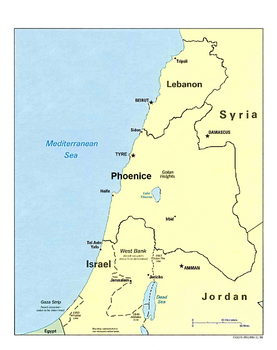
The Current Map of Phoenice
Area:
- total: 22,154.82 km2
- land: 21,903.82 km2
- water: 257 km2
Land boundaries:
- total: 605.86 km
- border countries: Lebanon 96.29 km, Syria 231.53 km, Jordan 175.23 km, West Bank 86.15 km, Israel 16.66 km
Coastline: 179.23 km
Maritime claims: territorial sea: 12 nmi (22.2 km; 13.8 mi)
Elevation extremes:
- lowest point: unnamed location near Lake Tiberias -200 m
- highest point: Mount Hermon 2,814 m
Religions[]
- 57% Maronite
- 5.2% Church of England
- 3.5% Roman Catholic
- 2% Islam (1.1% Sunni, 0.6% Shia, 0.3% Druz)
- 1.8% Judaism
- 1.4% Greek Orthodox
- 1.2% Greek Catholic
- 1% Protestant
- 2.6% Other Christians (Armenian Orthodox, Armenian Catholic, Syriac Catholic, Syriac Orthodox, Chaldean, Assyrian, Copt)
- 0.3% Other Religion (Buddhism, Hinduism, Sikhism, Mormonism, Freemasonry)
- 18% No Religion
- 6% Not Stated



